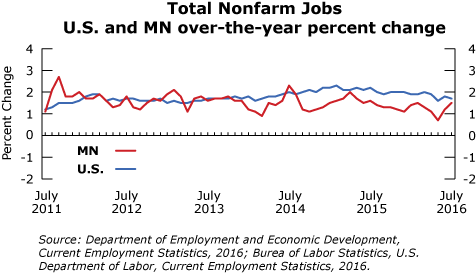by Nick Dobbins
August 2016
Monthly analysis is based on unadjusted employment data.
Employment in the Minneapolis-St. Paul MSA declined in July, off by 11,757 jobs (0.6 percent). By far the biggest July job losses in the MSA came in the Government supersector, which shed 18,006 jobs (7.1 percent). As is normally the case in July, the overwhelming majority of those jobs were cut from Local Government Educational Services, which dropped 17,566 jobs (19.2 percent) as schools in the area let out for the summer. Leisure and Hospitality added more jobs than any other supersector on the month, up by 2,435 (1.3 percent), with all published component sectors adding employment. Annually, the Twin Cities area added 36,024 jobs (1.9 percent). The only supersectors to lose jobs over that time period were Manufacturing (off by 424 jobs or 0.2 percent, thanks to a loss of 405 jobs or 0.3 percent in Durable Goods Manufacturing) and Information (off by 322 jobs, 0.8 percent). The largest source of growth remained Educational and Health Services, by a large margin, as the supersector added 13,220 jobs (4.2 percent) over July 2015 estimates. Leisure and Hospitality also saw significant gains on the year, adding 8,414 jobs (4.5 percent). Accommodation and Food Services accounted for 6,687 of those jobs (up 4.4 percent), with that gain driven by 8,051 new jobs (5.9 percent) in the Food Services and Drinking Places subsector. Arts, Entertainment, and Recreation, the other component sector, added 1,727 jobs (4.6 percent).
The Duluth-Superior MSA lost 1,605 jobs (1.2 percent) in July. Those losses were concentrated in Government (down 2,159 jobs or 8.4 percent) and more specifically in Local Government (down 1,960 jobs, 11.4 percent). Manufacturing employment also dipped, off by 69 jobs (1 percent). Leisure and Hospitality saw decent growth on the month, adding 320 jobs (2.1 percent). Annually, the Duluth area added 141 jobs (0.1 percent). While growth was small compared to statewide estimates, this marked the first time in a year that the MSA showed over-the-year employment growth instead of losses. The area was helped by the addition of 1,005 jobs (3.3 percent) in Educational and Health Services and 616 jobs (4.1 percent) in Leisure and Hospitality. Supersectors to lose employment included Mining, Logging, and Construction, which lost 846 jobs (8.3 percent), and Government, which lost 356 jobs (1.5 percent), with employment shrinking at all three levels (down 4, 2.6, and 0.7 percent in Federal, State, and Local Government, respectively).
Employment in the Rochester MSA was up by 149 jobs (0.1 percent) in July. It was the only MSA in Minnesota that didn’t lose employment for the month, as, although Government employers lost 684 jobs or 5.2 percent on the backs of a loss of 598 jobs or 5.7 percent in Local Government, this was balanced by gains in other areas. Notably, Manufacturers added 611 jobs (5.7 percent) for the month, the second consecutive month of gains in the supersector.
Annually, Rochester added 3,435 jobs (2.9 percent). Other Services, which lost 87 jobs (2.3 percent) was the only supersector in the area not to expand over that time period. Educational and Health Services, the largest supersector in the area, added 2,200 jobs (4.8 percent) over the year, driving much of the region’s job growth.
The St. Cloud metropolitan statistical area lost 1,433 jobs (1.3 percent) in July. Most of that loss came from Government employers, down 1,378 (8.8 percent) on a loss of 1,108 (12.1 percent) in Local Government. Notably, employment in Leisure and Hospitality also dropped in July, off by 386 jobs (4.4 percent) in a month that usually brings growth in the supersector for other MSAs, but generally shows losses in St. Cloud. Over the year, St. Cloud added 3,063 jobs (2.9 percent). Educational and Health Services accounted for most of that growth, adding 2,136 jobs (10.5 percent). Trade, Transportation, and Utilities also had notable gains, adding 736 jobs (3.4 percent) thanks in part to an additional 571 jobs (4.4 percent) in Retail Trade.
Employment in the Mankato-North Mankato MSA was off by 1,615 jobs (2.9 percent) in July. This nearly exactly matches the loss of jobs in Government, which was off by 1,624 (17.5 percent). Private Sector employers added 9 jobs (0 percent). Annually, the area added 924 jobs (1.7 percent). This gain came entirely from Service Providers (up 1,060, 2.4 percent), as Goods Producers lost 136 jobs (1.3 percent).
Employment in the Fargo-Moorhead MSA was down by 1,742 (1.2 percent) in July. Local Government employers shed 2,049 jobs (20.8 percent) during that time. Mining, Logging, and Construction added the most jobs in July, up by 269 (2.5 percent). Annually, the MSA added 2,424 jobs (1.8 percent). Mining, Logging, and Construction again had notable gains, adding 430 jobs (4 percent) for the year. Manufacturing was notable among the contracting supersectors, losing 264 jobs (2.7 percent) since July of 2015.
Employment in the Grand Forks-East Grand Forks MSA was off by 1,393 jobs (2.4 percent) in July. While employment dipped slightly in a handful of areas, the most significant losses came in Government employment which lost 1,879 jobs (13.5 percent) and specifically Local Government (down 1,804 or 30 percent). Annually, the area added 903 jobs (1.7 percent). Employment in Leisure and Hospitality was up by 271 (4.8 percent), and Mining, Logging, and Construction added 186 jobs (4.8 percent).
